- Home
- Peter Matthiessen
Sand Rivers Page 3
Sand Rivers Read online
Page 3
Karen Ross, who was in charge of the safari kitchen, and Robin Pope, a young assistant from Zambia, were also there to meet us, and soon Hugo van Lawick came in his own Land Rover, which is specially fitted out for photography; van Lawick had just observed five pups at a wild-dog den, less than a mile from our camp.
A comfortable cluster of green tents awaited us in a pleasant copse of palm and tamarind along the edge of the Kingupira Forest. We were greeted by Philip Nicholson, aged nineteen, a likeable blond boy and fanatical fisherman who was making a last safari with his family before going off to seek his fortune in Australia. The only person not yet among us was David Paterson, who was to fly in the following week with Rick Bonham's supply plane to the airstrip at Madaba, seventy miles to the southwest.
This camp by the forest, a few miles away from the present Game Department field headquarters and the near-moribund Miombo Research Center, had been one of Brian's first safari camps and also the site of an early game post. Among the courtesies extended to our expedition by the Game Department was a resident's permit to shoot impala, buffalo, and
SAND RIVERS
guinea fowl, to help feed its seventeen black and white participants, and after a fine first supper of impala and red wine, we sat around a campfire under the stars. Though at pains not to show it - he was already grumping about the scarcity of his beloved elephants - Brian Nicholson was very happy to be back. For the first time since I had met him, he did most of the talking, describing how he had first come to the Selous.
At the age of sixteen, Brian Nicholson abandoned his formal schooling in Nairobi and went to work for the noted animal collector Carr Hartley, who paid him "one hundred shillings a month and posho (rations)" and gave him his first lessons in dealing with large wild animals. The next year he signed on with a professional hunter named Geoffrey Lawrence-Brown and made thirteen or fourteen safaris as an apprentice hunter in order to qualify for his professional hunter's license. But being a "white hunter" did not interest him. He had always wanted to be a game warden, which in those days, he said, meant living in the bush and hunting and shooting to protect the shambas of the local people from the depredations of wild animals, especially elephant and lion. No such jobs were available in Kenya to a youth of his experience, and in 1949, at the age of nineteen, he signed on as a "temporary assistant elephant control officer" assigned to the region of the ill-fated Ground-Nut Scheme, which had its main headquarters at Nachingwea, in southeastern Tanganyika. "My qualifications were virtually non-existent," Brian said, "but nobody else wanted the job."
In its first years, the Ground-Nut Scheme was a threat to the southern Selous, which the planners thought might prove suitable for agriculture; in the absence of roads to Dar-es-Salaam, they planned to export 440,000 tons of ground-nuts annually through the new deep-water port being specially developed at Mtwara (where Maria's father was asked to set up a hospital, and where her sister Patricia was the first white baby to be born). But the Scheme collapsed under accumulated folly long before its grandiose ambitions could be implemented; among its many serious miscalculations was the failure to realize that by harvest time the ground-nuts planted in the soft mud of the rains would be locked under the hardpan of the dry season, and would have to be chipped out one by one. A little late, the planners asked themselves why this region was so thinly populated in the first place.
Nicholson's supervisor was Constantine John Philip lonides, then Senior Game Warden of southeastern Tanganyika and already a notable collector of rare animals and poisonous snakes; it was he who reported, for example, that the green mamba and the Gabon viper, at that time considered to be largely West African in distribution, were in fact very common on the Makonde Plateau, where Tanganyika bordered Mozambique. (Maria's father, who remembers lonides with fondness, once told
PETER MATTHIESSEN
me that the hospital verandahs at Mtwara were a favorite place for collecting cobras.) lonides and young Nicholson took to each other straight av^ay, and the next year Brian transferred to lonides's headquarters at Liwale near the southeastern boundary of the Selous and began the long series of foot safaris that were to acquaint him with most of the southern country.
By the time Nicholson appeared, in 1950, lonides considered that his great work of creation had been done; he was devoting more and more time to the hunting and collecting that had become his passions, and increasingly so as he realized that this new young assistant in elephant control whom the Africans called Bwana Kijana (the Young Bwana) was capable of taking over most of his duties and carrying out the final steps in his master plan. At one point in 1951, when lonides was off in the Sudan hunting for addax, Bwana Kijana was called in by the Provincial Commissioner at Lindi in regard to a Game Department request to incorporate this Lung'onyo River region into the Selous. The P.C. stepped over to a wall map and slowly traced the expanding outline of the Selous with his thumb, then said coldly to Nicholson, "You people are sterilizing this whole area." Remembering this, Nicholson remarked, "That man could never look you straight in the eye. Don't know where they found such people - hadn't a clue about Africa. All they thought about was giving these local Africans just what they wanted, whether it was good for them or not. No thought for the animals at all!"
In 1954 lonides went off on leave and, except to collect his things, never came back; he formally retired from the Game Department in order to give full time to collecting uncommon creatures on commission for various clients, including the Coryndon Museum in Nairobi. Since renamed the National Museum, it still displays lonides's gorilla group, bongo, and addax - pursued on camel back - and an assortment of other creatures, including the black mamba that, in 1942, crawled over his bare legs in the dark while he was seated in an outdoor privy in Liwale. lonides later credited this creature with inspiring the snake collecting avocation that eventually displaced the hunting of rare animals as the great passion of his life. Of the local Provincial Commissioner - perhaps the very one disliked by Nicholson - lonides once remarked, "He wasn't an attractive character: he didn't like snakes and he had beady eyes and damp hands." lonides was fond of saying that he found human beings the least interesting of all animals, which may have accounted for his reaction when in the dark a green mamba fell out of the thatch roof of a local hut on to a group of sleeping Africans and bit eight of them fatally before escaping from the panic that ensued. lonides, who succeeded in capturing this snake, was outraged: "If I hadn't been in that area, they'd have pursued it relentlessly and beaten it to death with sticks! Hooligans, insensitive dolts, thoroughgoing bastards!"
Like many another wounded by snobbery early in life, lonides
SAND RIVERS
became a snob himself, "a Royalist and imperialist of deepest-dyed hue", as he himself described it, a "dinosaur", to use the word of one of his colonial contemporaries, at least in all matters having to do with Africa and Africans. Before he acquired the name Bwana Nyoka, or Snake Man, lonides was known as Bwana Mparangozi, or He Who Takes the Hide Off Them, a name awarded for his unstinting use of the kiboko, or hippo-hide whip; on one occasion he prescribed flogging for all sixty adult males of a certain village. lonides later acknowledged that he might have been a bit too free with the kiboko. However, he said, "Flogging is a method that is simple and effective and very widely understood. ... In a primitive country you use primitive methods. For twenty-five years (c. 1935-60] this country's had a rule of fish-flabby hands in velvet gloves, and all it's done is to make third-rate Europeans out of a race of potentially first-rate Africans." In the same vein he remarked a few years later, "These people have been largely emasculated, that's what it arhounts to. Their splendid virtues have been driven out of them; it isn't their fault if we've turned them into a rather second-rate lot."
Quite apart from anything else, a certain nostalgia is apparent here: the man of "Old Africa" has always been more attractive to the white man then the "new African" who presumes to compete with him. Thus the unregenerate lonides, speaking at th
e time of Independence, could still refer to "our little black brothers, who haven't yet even developed a brain to think straight with, and certainly haven't contributed a single idea to the present sum-total of the civilization of mankind."^ One has to wonder about the effect of such an attitude on a very young, half-educated Kenyan from the White Highlands, which were already being claimed by the restless Kikuyu who would revolt in the Mau-Mau rebellion a few years later.
On one of the first of his long safaris Nicholson visited the Lung'onyo River, making his camp where we now were by the Kingupira Forest. There had been a report of heavy poaching, and everywhere he found hunters' blinds set up at the water pans and thorn fences that guided the game into set snares. In those days, poaching was a local enterprise, mostly for meat, which because of the tsetse fly and the virtual absence of livestock was in heavy demand. In a nearby Ngindo settlement he discovered some large stacks of hides, and sat himself atop a termite hill while his game scouts burned down the thatch village and placed its men under arrest. At the people's request, he spared the ngokwes (stilt storage huts) until the grain could be removed, and the next morning, several hours away along his route, he sent a few men back to finish off the job, under the leadership of a huge Ngoni Zulu named Nonga Pelekamoyo. ("The Ngoni like to give themselves resounding names; 'Pelekamoyo' means 'take your heart'.") Doubtless inspired by the memory of the great days when the Zulu armies from the south swept through this country, scattering the fearful Ngindo into the bush, Nonga
PETER MATTHIESSEN
Take-Your-Heart put the torch to every community that he passed, an estimated ninety huts m all, an outrage for which, the following year, Bwana Kijana was summoned to Game Department headquarters at Arusha, and forced to stay there for approximately six months. "This old man who met us at the airstrip" - Brian pointed at Saidi Mwembesi -"he's the nephew of old Nonga, and he has a son who's m the Game Department now. Those people are a Game Department family."
In 1955, when Brian took his first leave from the Game Department, he was no longer Bwana Kijana but a full-fledged Bwana Nyama, or "Mister Game", as the Africans called the Game Department wardens (or "Mister Meat", Brian said wryly, choosing the other meaning of nyama], and so absorbed in his job that he did not want to take leave at all. "In those days," he says, "they used to make us take overseas leave, and so I decided to visit the U.K." At the Overseas Club in London, where he went for want of any destination, he met a pretty Australian girl named Melva Peal. Miss Peal came out to Africa in August of that year, and despite the warnings of lonides, who had avoided women all his life, and who assured Nicholson that domesticity would never mix with a life in the bush, they were married in January 1956, proceeding immediately to NachingWea. This erstwhile hub of the Ground-Nut Scheme, with its grandiose avenues and city planning, "was a dead city by the time I got there," Melva said. "There were hardly any Europeans left. I was there three days, and without any furniture, when Brian left on a six-week safari. He just handed me a gun and said, 'If anybody tries to break in here, shoot him.'"
All three Nicholson children - Susan, Sandra, and John Philip (named for lonides) - were born in Nachingwea: Susan is married now, living in Bangkok. "Brian was hunting a man-eating lion down near Mtwara when Susan was born," Melva remembered. "Fourth of August, 1956." But five years later, Nicholson was made Senior Game Warden for the southeast sector of what was now the independent nation of Tanzania, a sector that included all of the Selous, and was posted to the large agricultural center of Morogoro, north of the Reserve, where traders were sponsoring the rampant poaching. As Brian wrote a few years later:
It is necessary to digress for a while and examine events which were affecting Tanganyika as a whole, for these have a direct bearing on the policies concerning the Selous, the Government's acceptance of our requirements in land, and the availability of the land itself. From the earliest days there never was any official policy directed towards development of Game Reserves. These were simply areas set aside for the maintenance of wildlife, and the idea that they could play an important part in the economy of the country was never seriously considered. This goes a long way to explain the negative attitude adopted by the Colonial Administration towards
SAND RIVERS
wildlife. With a few notable exceptions most officers in Government service looked upon game as a problem - either to cattle or cultivation - and Game Reserves a's useless tracts of land which could not be used for anythmg else. Game Rangers were cranks to be tolerated, and the Game Department was a sort of Cinderella which was grudgingly allocated inadequate funds and staff to be used mainly on game control work.
The picture began to change in about 1955 when the impact of tourism and foreign earnings began to assume increasing importance to the East African territories. It was apparent from the start that East Africa's unique wildlife was the main attraction. With the development of National Parks, and growing local and international interest in East Africa's wildlife, the Game Department began to expand and carry more influence. As a result the staff and financial problems became easier, and the proposals for protecting and utilizing wildlife were taken seriously, in high levels of Government. By 1958 it was clear that the country was moving towards independence, and the need to establish a foundation for an economically self-supportmg state undoubtedly had its effects on promoting tourism, and through this tlje development of wildlife. In practice the National Parks got the lion's share of funds and publicity, but we in the Selous Game Reserve benefited increasingly from 1958 onwards. At this stage there was still no definite plan for any form of development within this or any other Game Reserve, and the idea of strictly controlled hunting was looked upon as sacrilege. (1 had in fact prematurely suggested this as far back as 1951.) The prevailing view at Game Department Headquarters was that all really good game areas should become National Parks, and that we were merely the caretakers until that happened. Some of us did not agree with this policy, since it was perfectly clear that huge areas of our Reserves were utterly unsuitable for National Park purposes. It was not until late 1961, when Major B. G. Kinlock became Chief Game Warden, that alternative uses for the Reserves was accepted, and the idea of carefully controlled hunting became policy in the Selous Game Reserve.
Though his responsibilities had now shifted from elephant control and anti-poaching to conservation and development, Brian continued to spend as much of his time as possible in the Selous, which had been his special interest from the start. At this time he was still implementing lonides's master plan, and he showed me on a map the boundary extensions that he had brought about during the 1960s; these included crucial additions in the north, east and south, most of them designed to spare outlying wildlife populations from black hunters (who brought in no revenue), the better that they might be killed by white. By the early
PETER MATTHIESSEN
1970s, hunting safaris were not only supporting the whole operation of the Selous (three main Game Department bases, including Kingupira, a staff of 460 people, well-manned game posts, 3500 miles of dry-season track, three ferries, and three bridges) but producing revenues for the government as well: the Reserve was divided into 47 hunting blocks, each with a predetermined, low annual quota for each species, and the 94 hunting safaris that came to the Selous in 1972 paid out 1.5 million shillings in trophy fees alone.
The 1960s and very early 1970s were prosperous years for East African wildlife, when a great amount of money was brought in from Europe and America due to the efforts of able administrators, in particular John S. Owen, Director of Tanzania National Parks. (It was John Owen, an old friend of the Eckhart family, who had introduced me to Maria.) Owen himself and all his wardens suddenly found themselves flying airplanes, as did many of the research biologists attached to the Serengeti Research Institute; the fashion for airborne wardens and biologists spread like bush fire, even to poor relations of the Parks such as the Game Department. In 1969, Brian Nicholson learned to fly when the Game Department acquired so
me small airplanes, and 24 airstrips were added to the efficient system with which he now administered the Selous. That same year, he was transferred to Game Department headquarters in Dar-es-Salaam as "principal Game Warden and Advisor to the Government on Development Projects" - among others, the planning of which regions of the country would serve best as national parks and which as game reserves. Nicholson promptly arranged for the extraction of what he called "the big thorn in my side" - the Mikumi Game Reserve, a much smaller area north of the Selous which was crossed by a new highway from Dar-es-Salaam to Iringa and therefore wide open to poachers in a relatively populous region. Mikumi was simply not large enough or special enough to deserve all the game scouts needed to patrol it; being so close to the highway and the towns, it would work much better as a national park, an idea very agreeable to John Owen. As Mikumi National Park, it now protects a whole stretch of the Selous's northern boundary (though the two are separated by the tracks of the Great Uhuru Railroad, built by the Chinese, that links Dar-es-Salaam to the Zambia copper belt).
When Africans replaced Owen and his parks wardens with the "Africanization" of European jobs in the early 1970s, the wildlife industry lost much of its international appeal, and the decline of Tanzanian government interest followed swiftly. By 1973, Nicholson told me, "everything was beginning to fall apart." The Game Department funds had been cut off, and there was mismanagement of what was left, together with wholesale incompetence. In March 1973, in desperation, Nicholson and Alan Rodgers submitted a report to the Ministry of Natural Resources and Tourism deploring the withdrawal of financial

 Lost Man's River: Shadow Country Trilogy
Lost Man's River: Shadow Country Trilogy The Tree Where Man Was Born
The Tree Where Man Was Born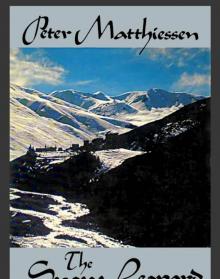 The Snow leopard
The Snow leopard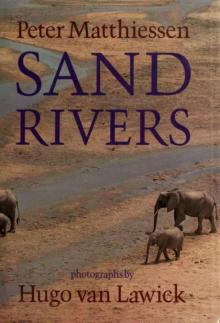 Sand Rivers
Sand Rivers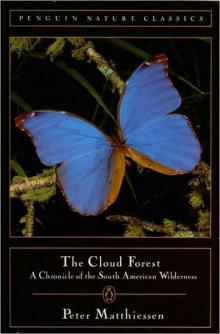 The Cloud Forest
The Cloud Forest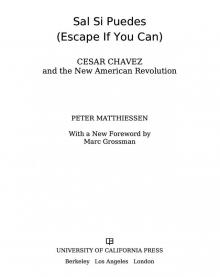 Sal Si Puedes (Escape if You Can)
Sal Si Puedes (Escape if You Can)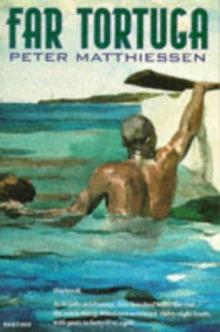 Far Tortuga
Far Tortuga Men's Lives
Men's Lives On the River Styx: And Other Stories
On the River Styx: And Other Stories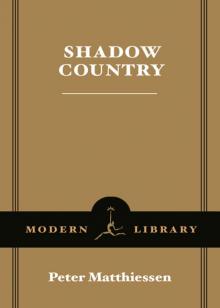 Shadow Country
Shadow Country At Play in the Fields of the Lord
At Play in the Fields of the Lord Lost Man's River
Lost Man's River Killing Mister Watson
Killing Mister Watson On the River Styx
On the River Styx